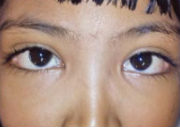Epiblepharon
Extra fold of skin in the lower lid with inturning of eyelashes
Nasal 1/3rd is most commonly affected
Treatment: Plastic repair if necessary to prevent recurrent infection.
Euryblepharon
Rare, congenital, bilateral, not so serious condition
and may be with epicanthus
Treatment:
No treatment for most of the cases; lateral tarsorrhaphy for symptomatic cases.
Extra fold of skin in the lower lid with inturning of eyelashes
Nasal 1/3rd is most commonly affected
Treatment: Plastic repair if necessary to prevent recurrent infection.
Euryblepharon
Rare, congenital, bilateral, not so serious condition
- Palpebral apertures are larger than normal
and may be with epicanthus
- Excessive watering may be a problem due to more exposure
Treatment:
No treatment for most of the cases; lateral tarsorrhaphy for symptomatic cases.














